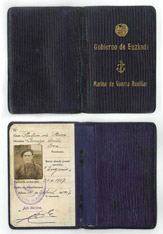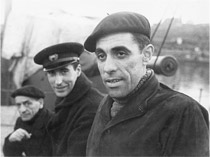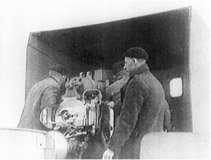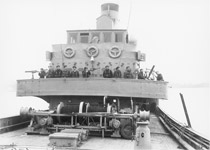When the first cod fishing boats selected to be armed were seized, their crews were a cross section of civil and military sailors, some from their original crews and others embarked by the Republican Navy. In order to ensure these vessels and all others belonging to the Basque Navy, all were crewed by volunteers under the control of the Basque Government. The Sea Volunteers Decree was published on 10th november 1936.
 The Sea Volunteers was a military corps manned by civilian volunteers. In principle, registration was open to any person that had sailed in the merchant navy or worked as professional coastal or high seas fishermen for at least six months. Over 3,000 volunteers applied. They ranged in age from 18 to 60 years old and from all professional categories: masters, pilots, owners, engineers, stokers,… even though they had little military training. In accordance with the reports provided by the trade union and political organisations to which the volunteers belonged, the necessary personnel was selected to crew the vessels and some shore establshments. Only a few were initially selected – around 350 men – but in June 1937, after the mobilisation of the drafts from 1924 to 1938, it grew in number up to nearly 700, including the crew posted to various vessels and the offices of the Cantabrian Sea Naval Forces (Cantabrian Sea is the Spanish name for the Bay of Biscay). In total, over 900 people served in the ranks of the Auxiliary Navy.
The Sea Volunteers was a military corps manned by civilian volunteers. In principle, registration was open to any person that had sailed in the merchant navy or worked as professional coastal or high seas fishermen for at least six months. Over 3,000 volunteers applied. They ranged in age from 18 to 60 years old and from all professional categories: masters, pilots, owners, engineers, stokers,… even though they had little military training. In accordance with the reports provided by the trade union and political organisations to which the volunteers belonged, the necessary personnel was selected to crew the vessels and some shore establshments. Only a few were initially selected – around 350 men – but in June 1937, after the mobilisation of the drafts from 1924 to 1938, it grew in number up to nearly 700, including the crew posted to various vessels and the offices of the Cantabrian Sea Naval Forces (Cantabrian Sea is the Spanish name for the Bay of Biscay). In total, over 900 people served in the ranks of the Auxiliary Navy.
Once they had joined up, they were under the laws and jurisdiction of the Navy and subject to military discipline. All the volunteers received working and street uniforms. The first were overalls and the second consisted of a jacket and trousers that ranged from greenish grey to dark blue, together with fisherman’s boots and a dark beret. They did not use insignia or braids to identify the different ranks, even though a project was on paper.
 The commanders of the trawlers were given the rank of lieutenants, even though the rest of the hierarchy kept the terms existing in the Merchant Navy. The ranks of the Deck Officers were commander, 1st, 2nd and 3rd officer. The commanders of the Goizeko and the Iparreko and the masters of the minesweepers and canoes were equivalent to the 1st Officer. The ranks used for the engine room were chief, 2nd and 3rd engineer and assistant engineer or 4th engineer, and the system was parallel to the Deck Officers. The engineers of the Goizeko and the Iparreko were considered to be equivalent to the 2nd engineer. The telegraphists and health personnel (doctors and nurses) were also officers in the Basque Navy.
The commanders of the trawlers were given the rank of lieutenants, even though the rest of the hierarchy kept the terms existing in the Merchant Navy. The ranks of the Deck Officers were commander, 1st, 2nd and 3rd officer. The commanders of the Goizeko and the Iparreko and the masters of the minesweepers and canoes were equivalent to the 1st Officer. The ranks used for the engine room were chief, 2nd and 3rd engineer and assistant engineer or 4th engineer, and the system was parallel to the Deck Officers. The engineers of the Goizeko and the Iparreko were considered to be equivalent to the 2nd engineer. The telegraphists and health personnel (doctors and nurses) were also officers in the Basque Navy.
 The coastal skippers (sometimes called 1st class skipper) considered to be the equivalent of 2nd officer and fishing skippers (or 2nd class skippers) with the rank of subordinate were intermediate auxiliary ranks on Deck. In the engine room, there were the ranks of 1st mechanic or 1st motor mechanic, equivalent to 3rd engineer, and the 2nd mechanic or 2nd motor mechanic, with the rank of subordinate. This rank was held by the skilled engineers and skilled stokers on the minesweepers. In June 1937, the posts of quartermaster general or office clerk were also created.
The coastal skippers (sometimes called 1st class skipper) considered to be the equivalent of 2nd officer and fishing skippers (or 2nd class skippers) with the rank of subordinate were intermediate auxiliary ranks on Deck. In the engine room, there were the ranks of 1st mechanic or 1st motor mechanic, equivalent to 3rd engineer, and the 2nd mechanic or 2nd motor mechanic, with the rank of subordinate. This rank was held by the skilled engineers and skilled stokers on the minesweepers. In June 1937, the posts of quartermaster general or office clerk were also created.
Finally, the last scale consisted of the Seamanship (boatswain, leading seaman, seaman, ship's boy), Engine-room (boiler stoker, greaser, stoker and scooper), Radio (telephonist), Artillery (gunner and artillery corporal) and Catering (1st and 2nd chef, first and second steward and cleaner). All the crew posted to the motor canoes had the category of seamen, although some of them received names such as canoe skipper or motor launch mechanic.
 The majority of the Sea Volunteers came from the Basque coastal towns, over half of them were from Vizcaya (57 %), and the high number of people from Bermeo was particularly notable (over 11 % of the total). Just over a quarter were from Guipuzkoa (28 %) and there was just a handful from Alava and Navarra (around 1 % between both). The remainder (14 %) were born outside Euskal Herria, most of whom were from Galicia (10 %), and also from Cantabria, Andalusia, Castilla, Aragón, Asturias, Madrid and Catalonia. As far as their political allegiance was concerned, 57 % belonged to Solidaridad de Trabajadores Vascos or Partido Nacionalista Vasco, 19 % was from the UGT or the Socialist Party and a lower percentage belonged to the CNT (5 %), Acción Nacionalista Vasca (4 %), Izquierda Republicana (2 %), the Communist Party (2 %) and various professional trade unions (1 %). Finally, 10% were not members or little is known about their allegiance.
The majority of the Sea Volunteers came from the Basque coastal towns, over half of them were from Vizcaya (57 %), and the high number of people from Bermeo was particularly notable (over 11 % of the total). Just over a quarter were from Guipuzkoa (28 %) and there was just a handful from Alava and Navarra (around 1 % between both). The remainder (14 %) were born outside Euskal Herria, most of whom were from Galicia (10 %), and also from Cantabria, Andalusia, Castilla, Aragón, Asturias, Madrid and Catalonia. As far as their political allegiance was concerned, 57 % belonged to Solidaridad de Trabajadores Vascos or Partido Nacionalista Vasco, 19 % was from the UGT or the Socialist Party and a lower percentage belonged to the CNT (5 %), Acción Nacionalista Vasca (4 %), Izquierda Republicana (2 %), the Communist Party (2 %) and various professional trade unions (1 %). Finally, 10% were not members or little is known about their allegiance.
 Apart from the crew at sea, there were logically the shore staff working in offices, workshops, warehouses, lookout towers and surveillance posts. This personnel, except in rate exceptions, did not belong to the Sea Volunteers or were subject to military discipline and jurisdiction. In the administrative sphere, there the categories of Section head, which was only held by Egia, Division head (the secretaries, inspectors and technical advisors also held a similar rank), 1st, 2nd, 3rd and administrative officer, typists, porters (drivers were similar to this category) and auxiliary. The lookout officers, assistants and guards (sometimes called coast guards) manned the lookout towers and vantage points. The administrative staff included the only women working for the Basque Navy. Specifically three who worked in the offices at Headquarters. They were Paquita García, Mª Luisa Jiménez Alzaga and Miren Leanizbarrutia.
Apart from the crew at sea, there were logically the shore staff working in offices, workshops, warehouses, lookout towers and surveillance posts. This personnel, except in rate exceptions, did not belong to the Sea Volunteers or were subject to military discipline and jurisdiction. In the administrative sphere, there the categories of Section head, which was only held by Egia, Division head (the secretaries, inspectors and technical advisors also held a similar rank), 1st, 2nd, 3rd and administrative officer, typists, porters (drivers were similar to this category) and auxiliary. The lookout officers, assistants and guards (sometimes called coast guards) manned the lookout towers and vantage points. The administrative staff included the only women working for the Basque Navy. Specifically three who worked in the offices at Headquarters. They were Paquita García, Mª Luisa Jiménez Alzaga and Miren Leanizbarrutia.
